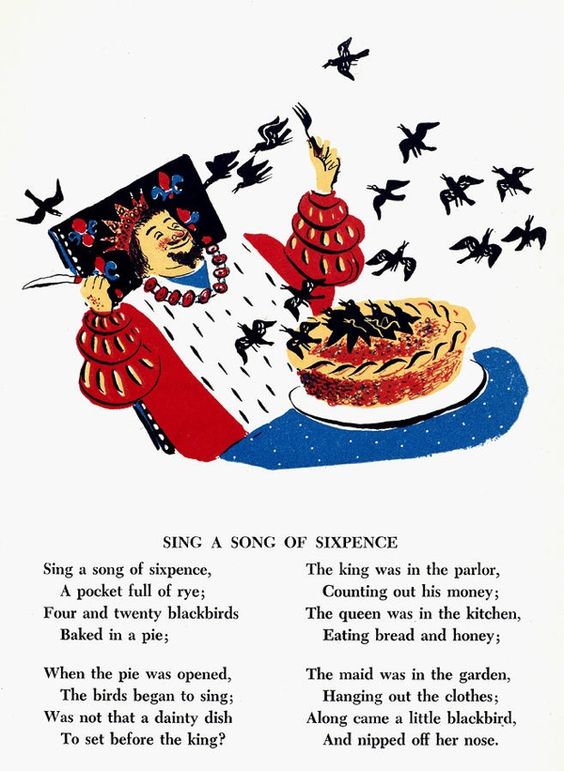Why You Don’t Want to Eat Blackbird Pie
Nursery rhymes are, by and large, weird. Little Red Riding Hood deals with a talking wolf. Goldilocks has to navigate the home of bears who sleep in beds. The three little pigs also struggle with talking wolf. And let’s not even start with Humpty Dumpty. If you’re looking for realism in your early-childhood literature, nursery rhymes probably aren’t the way to go.
Unless you’re dealing with baked goods, maybe.
You’re probably familiar with the nursery rhyme “Sing of Song of Sixpence.” But if not, no worries! Here’s the poem and an accompanying illustration from some children’s book.

If you can’t see the image above, the relevant part of the poem tells us that “four and twenty blackbirds [were] baked in pie” and “when the pie was opened [by a king], the birds began to sing.” The implication is that the birds were baked into a pie but survived the ordeal, and the illustration in the above tells the same story: there’s a king sitting down to eat a pie, with fork and knife in hand. He appears to have cut the pie open but instead of seeing a meal, he’s greeted with twenty-four blackbirds that fly away and, presumably, sing as well.
That’s a really weird pie, which is consistent with other nursery rhymes — they’re all fantastical stories of things that don’t exist in the real world, right? Usually, when you cut open pies, you’re met with apples or pecans or (in the case of chicken pot pie) maybe something savory, but in any event, your dinner isn’t going to sing and fly away. The poem has to be an allegory for something, right?
Well, maybe not.
We don’t know the origins of “Sing a Song of Sixpence” — there are printed versions of it dating back to the late 1700s, but it’s widely believed that the poem was passed down from generation to generation orally for decades if not a couple of centuries before that. The first sixpence was coined in 1551, so it’s probably no older than that, but again, we can’t be sure. As a result, there are lots of theories as to what the original author was referencing here. In 2005, NPR sat down with Chris Roberts, who wrote a book titled “Heavy Words Lightly Thrown: The Reason Behind the Rhyme,” and explored some of the theories. Roberts told the radio broadcaster that the singing birds may just be an allegory for “the whistling of the steam when the pie is cooked,” or, perhaps, a reference to Henry VIII. This theory, as shared by Roberts, has the poem “telling the story–the first queen is off in the parlor, kind of out of the action and that the second queen, who Henry divorced and then executed, has her nose snipped off by the blackbirds, which here apparently represent the church.”
Sounds plausible, sure. But here’s another theory: maybe the blackbirds were just blackbirds.
In the 16th century — around the time Henry VIII was in power — French cuisine adopted a course called an “entremet,” or, as The Independent (Ireland) explains, “a dish served between courses as a novelty item for the entertainment of the nobility and upper classes.” Entremets weren’t intended to be eaten, but to an outsider who didn’t know better, that could be a surprise. The Independent provides an example:
A big, wide pie was baked for a royal banquet and over it a large dome of pastry was placed with a collection of live songbirds housed under the crust. The creation was carried to the table, the outer crust of the pie was opened and to the delight of the assembled guests the birds flew out calling as they escaped from their confinement within the outer pastry casing.
And there’s reason to believe the practice was rather common. In 1549, an Italian author named Giovanni de Roselli published a cookbook that outlined some of the fancier ways to delight one’s guests. The book was translated in 1598 and titled “The Italian Banquet.” The translation of Roselli’s book includes a recipe explaining how “to make pies so that birds may be alive in them and fly out when it is cut up” The recipe, as seen here, effectively tells the cook to make a pie crust like he would usually do, but then to cut a large hole in the bottom so that the birds can be placed underneath. When the crust was cut open, the birds would escape their pastry prison and fly to freedom, but not before getting a loud ovation from the gathered dignitaries.
So again, we don’t know what the nursery rhyme is referencing — such facts are lost to history. But either way, blackbird pie was a real menu item at one point, although not one ever eaten. And it’s not one that will likely ever hit modern menus, as having live birds flying around a restaurant is probably not a great experience.
Bonus fact: Blackbirds were probably part of the original lyrics to the song “The Twelve Days of Christmas.” On the fourth day of Christmas, per the song, the singer’s true love gave to him or her “four calling birds,” per modern renditions. But the original lyrics likely referenced “four colly birds,” per the Library of Congress. The term “colly birds” has fallen out of fashion over the last century or so (and therefore replaced by “calling birds” today) but likely referenced blackbirds when the song was originally written.
From the Archives: Putting It Together Again: Humpty Dumpty is an egg. Right? RIGHT?
